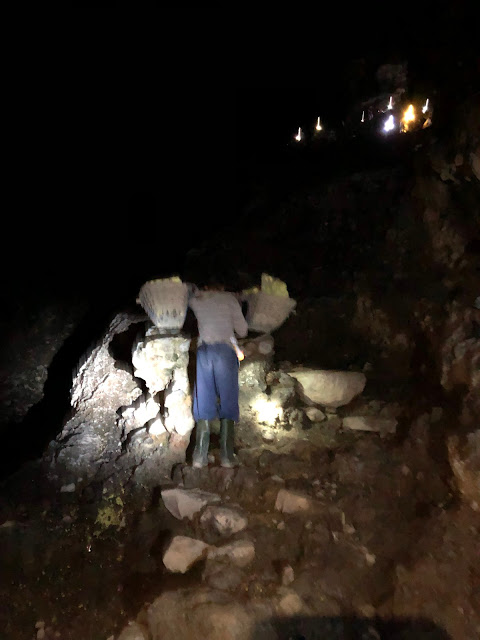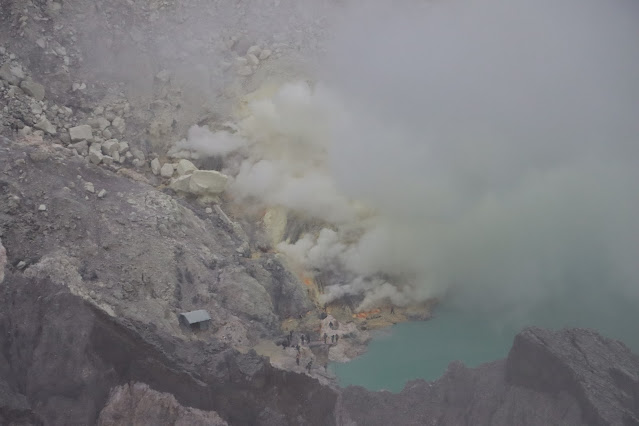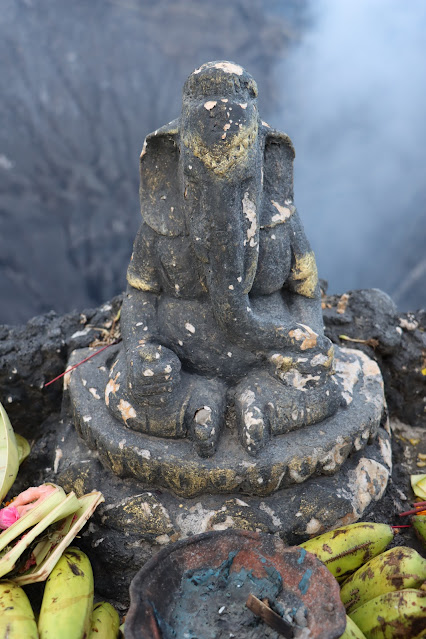
Looking back to the west end of Bali.
We stayed a a lovely hottl north of Banyuwangi looking out over the strait. There was a large wedding going on while we had dinner--so many women decked out in beautiful, colorful, sparkling wedding like dresses with matching jilbabs (hijabs)
We slept from 8:00 pm to about 11:30. At 12:15 we headed out. We started from the Ijen trail head at about 2:00. It was a straight up steep climb, but at least the trail was well worn and easier to follow than Tambora. Once on top we then descended down a rocky rough trail into the crater where sulfur rises on the shore of a turquoise lake giving up blue flames as it solidifies into yellow cakes of sulfur. The sulfur is then mined by local men who then carry the sulfur up out of the crater and down the mountain on their backs. The sulfur gives off nasty fumes, so most hikers wear gas masks. These two photos show the miners hauling their quarried sulfur up out of the crater as a line of head-lamped hikers walk down. What a tough way to make a living.
There are only two places in the world where these blue flames are found--Iceland and Ijen. One of our guides joked and said there was a third place--the blue flames on our kitchen gas stoves.
It was such a beautiful morning, watching the changes of colors.
The crater rim with tourists and sulfur miners.
I bought a small piece for my rock collection. The hard working miners, have my respect. It is a tough climb.
We were back to our hotel by 9:00. We enjoyed a delicious breakfast, showered, rested and then were on the road by 11:30. Next stop (after a six hour drive) was a small, cheap hotel half way up our next volcano--Bromo. We slept a few more hours this night but were on the road by 3:00.
On July 4, 1977, a group of us missionaries climbed Bromo and watched the sunrise (the one time on my mission I felt cold). We were then stupid enough to walk around the whole rim. On the far side, on a narrow trail with steep slopes on both sides and unstable rocks underneath us, I remember thinking that my mom's prayers for the safety of her son may not cover crazy 20 year olds thinking they are invincible. We were however, smart enough to turn down an offer by a local Tenggerese man to lead us down into the crater--which at the time was mostly solid rock, unlike the current slope that is eroded ash.
Here are three photos from my 1977 climb.
He offered to take us down into this crater. It did look safer back then.
Will called for me to stop so he could take my photo (below). I love it.
Heading back to the steps down.
The local Tenggerese are related to the Balinese and are also Hindu. Here Ganesha receives offerings.
During the pandemic the stairs were refurbished and cleaned of all the ash that has been deposited on and off over the past few years.
The jeep parking lot. Some in our group would have enjoyed a jeep ride in but they come later and bring crowds. I prefer an earlier departure and the solitude of an early arrival on the summit.
Steaming Bromo on the right and a cloud covered Mt. Semeru peeking out in the distance (the tallest volcano on Java and also a holy mountain for Balinese and Tenggerese).
A classic photo of smoking Bormo and Semeru.

















































































































No comments:
Post a Comment